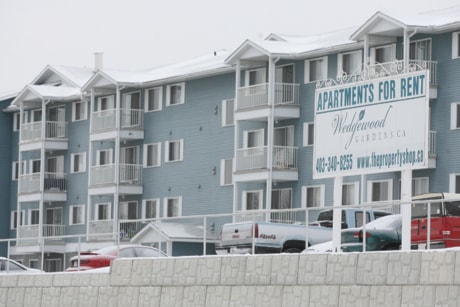Local apartment hunters may be having a tougher time finding accommodation this fall than last, but the rent they’ll have to pay could be lower.
Canada Mortgage and Housing Corp.’s fall rental market survey, released on Thursday, indicates that the average vacancy rate for private apartments in Red Deer in October was 7.5 per cent — down from 9.2 per cent a year earlier. The national housing agency also calculated that the average rent for apartments of all sizes in the city was $770, a drop from $793 in October 2009.
The CMHC survey revealed a trend toward lower vacancy rates and rents across Alberta. The average vacancy rate in urban centres with 10,000 or more people was 4.6 per cent in October, as compared with 5.5 per cent last fall, while the average rent for two-bedroom apartments slid to $1,036 from $1,044.
“This reduction in vacancy is attributed to an increase in employment levels across the province, as well as recent gains in interprovincial and international migration,” said Lai Sing Louis, a regional economist with CMHC.
But, noted Louis, vacancy rates in some urban centres remain at historically high levels. This was cited as a factor in the decline of rents.
Lacombe had the highest vacancy rate among Alberta’s larger urban centres, at 11.6 per cent, although CMHC cautioned that its data for the town was of questionable reliability. Last October, Lacombe’s vacancy rate was 9.3 per cent.
Brooks was next at 10.6 per cent, down from 9.5 per cent; Grande Prairie was at 10.5 per cent, down from 15.5 per cent; and Medicine Hat came in at 10.1 per cent, an increase from 9.3 per cent.
The lowest vacancy rate was in Sylvan Lake, at 0.9 per cent — a year-over-year drop from 7.1 per cent. The second lowest was Canmore, which declined to 1.2 per cent from 6.3 per cent.
The vacancy rates in Red Deer varied with apartment size. The average for bachelor units in October was 9.4 per cent, up from 6.4 per cent a year earlier; for one-bedroom suites it was 5.1 per cent, down from 8.7 per cent; for two-bedroom apartments, the average was nine per cent, a decrease from 9.8 per cent; and the rate for units with three or more bedrooms was 5.9 per cent, a drop from 9.8 per cent.
When it came to average rents, the October figure for bachelor suites in Red Deer was $592, down from $603; one-bedroom units were renting for $706, from $725; two-bedroom apartments averaged $817, from $850; and units with three or more bedrooms were $933, from $938.
Nationally, CMHC determined that the average rental apartment vacancy rate in October was down in 35 major Canadian centres — to 2.6 per cent from 2.8 per cent in October 2009.
It was hardest to find a rental unit in Winnipeg, where the vacancy rate was 0.8 per cent, followed by Regina, Kingston, Ont., and Quebec City, at one per cent each.
Vacancy rates were highest in Windsor, Ont.; Abbotsford, B.C.; Saint John, N.B.; and London, Ont.
Monthly rent amounts for a two-bedroom unit rose about 2.4 per cent year over year to $860 from an average $836 last October.
Vancouver, at $1,195, Toronto, at $1,123, and Calgary, at 1,069, were the most expensive cities to rent in.
Average rents were lowest in three Quebec cities: Trois-Rivieres ($533), Saguenay ($535) and Sherbrooke ($566).
CMHC’s rental market survey is conducted every April and October.
hrichards@www.reddeeradvocate.com, with files from The Canadian Press
